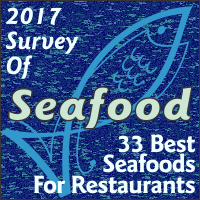 Our annual survey of seafood in Southeast Louisiana this year counts down the 33 best seafood species enjoyed in our restaurants, seafood markets, and homes. For the full survey so far, click here.
Our annual survey of seafood in Southeast Louisiana this year counts down the 33 best seafood species enjoyed in our restaurants, seafood markets, and homes. For the full survey so far, click here.
#11: Lump Crabmeat
#5: Lump Crabmeat
Our list includes separate looks at crabmeat and soft-shell crabs, with the latter higher on the the list. The favorite trick of waiters and chefs is making an ordinary dish seem irresistible by just throwing a little crabmeat on top. That's how appealing crabmeat is. And with good reason. Aside from people who are allergic to it, who doesn't love crabmeat? Even so, using crabmeat as a price-elevating garnish is the least interesting way to use this fantastic local seafood. The best way is to serve it more or less as it comes out of the crab's shell. If there's a sauce, it should be a light one. The subtle flavor of our local blue crab is so distinguished that it needs no help. Lump crabmeat is found in several forms, from the most expensive to the least: a. Crabmeat marbles are the largest lumps from the biggest male crabs. It's hard to find in stores because the restaurants buy most of it up. b. Jumbo lump crabmeat, also called "backfin lump." This is the big lump of meat toward the back of the crab, where it's the strong muscle that operates the crab's flippers. There's a little sliver of thin shell in there that's difficult to remove without breaking the lump. If you see that, it's sign that you're eating real jumbo lump. Unfortunately, most of the crabmeat called "jumbo lump" on menus isn't really. c. Other white crabmeat, also called "special white." This is generic lump crabmeat, less expensive, more available, but not as good as the true jumbo lump crabmeat. The flavor is a lot like jumbo lump, but it's not eye-popping. If you're getting crab cakes for under $18, it's probably made with this, not the "jumbo lump" the waiter keeps saying. Good for making soups and sauces, and for topping fish fillets, veal, poached eggs, and pasta with cream sauces. d. Claw crabmeat is the least expensive kind of crabmeat, but has the most assertive flavor of any part of the crab. It's perfect for stuffings and dressings. It doesn't look as good, however--the meat is dark and stringy. Funny, isn't it, that even in the realm of food, the prettiest actors are considered the dearest? Universally available wherever crabmeat is sold. Crabmeat has shot up in price in recent years because our crabs have become part of the national market. The people along the Chesapeake Bay--who have the same kind of crabs we do and a similar crab-eating culture--buy up a titanic quantity of our crabs. The meat is in demand all across the nation. On the other hand, producers of crabmeat in South America and Asia have entered the market with pasteurized crabmeat in sealed cans. It's much cheaper, and for the price it's not terrible, but it has nothing on fresh local crabmeat. This year, there has been a moratorium on the commercial capture of blue crabs. The ban ends in about a week, and doesn't affect the crabmeat you buy in containers at the store. The reason for it is that at the end of the season last year the crab population was lower than normal. The moratorium gives the crabs a break, so they can get it on and produce another generation of crabs, all in the service of that waiter who wants to put crabmeat on everything. Crabmeat is one of our great local delicacies. The season for crabmeat is just beginning now. Enjoy it while you can!